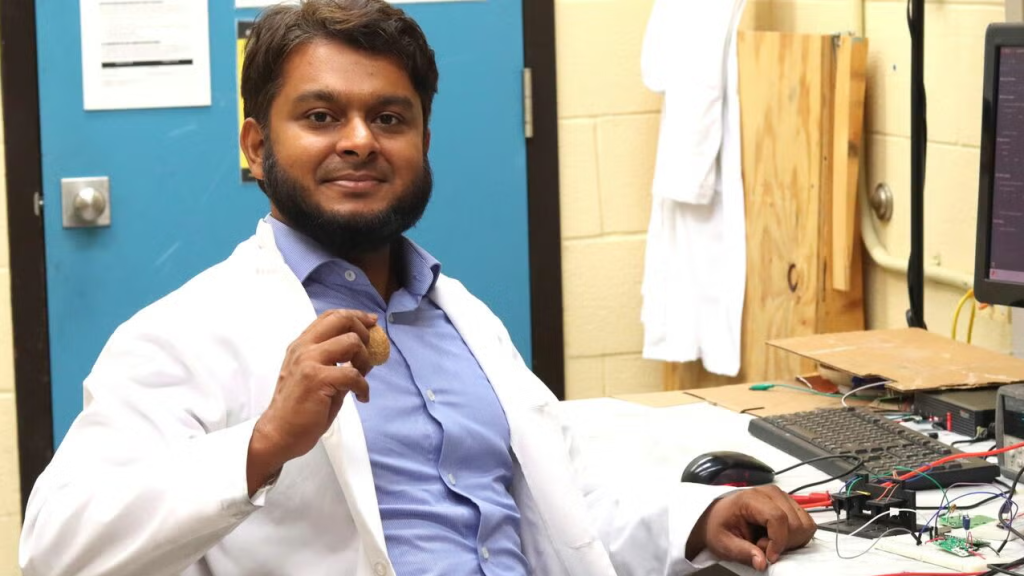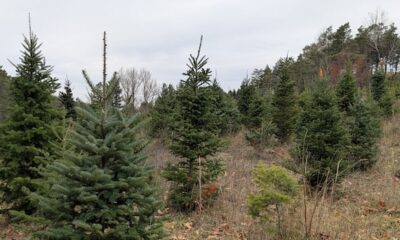Science
Researchers Harness Walnut Shells and Water to Generate Electricity

Researchers at the University of Waterloo have developed an innovative technology that transforms discarded walnut shells and a single drop of water into electricity. This breakthrough involves a process known as hydrovoltaic energy harvesting, which utilizes the unique internal structures of walnut shells to transport electrically charged ions efficiently.
PhD student Nazmul Hossain, who is part of the research team, explained that the process requires no complex preparation. “It all happens with nothing more than a single droplet of water and the shell’s natural architecture, no crushing, soaking, or complex processing needed,” Hossain stated. This simplicity underscores the potential of using waste materials to create clean energy.
Innovative Energy Solution
The newly developed device, termed the water-induced electric generator (WEG), harnesses the evaporation of water within the porous structure of walnut shells. This technology is compact, roughly the size of a coin, and includes basic components such as shells, water droplets, electrodes, wires, and a 3D-printed base.
Testing began after Hossain examined hazelnut shells under an electron microscope, revealing their complex internal designs that naturally facilitate nutrient and water transport. Subsequently, the team explored various nut shells, identifying walnut shells as the most promising option for electricity generation.
“This technology could be a transformative solution for powering small electronic devices, especially in remote or off-grid areas,” Hossain added. He envisions applications including environmental sensors that monitor forests, Internet of Things (IoT) devices, and wearable health monitors, all powered by tiny water droplets harvested from the environment.
Future Prospects and Applications
Looking ahead, the research team aims to enhance the technology by developing a wearable device capable of harvesting moisture from sweat or rain. This innovation holds the potential to power a range of small devices and sensors, as well as to detect water leaks in various settings.
The project is part of a broader trend of technological advancements emerging from the University of Waterloo, as researchers continue to explore sustainable solutions to energy challenges. With the WEG, the possibility of generating electricity from waste materials could pave the way for significant environmental benefits, demonstrating the effectiveness of nature-inspired technologies.
-

 Politics4 weeks ago
Politics4 weeks agoSecwepemc First Nation Seeks Aboriginal Title Over Kamloops Area
-

 World5 months ago
World5 months agoScientists Unearth Ancient Antarctic Ice to Unlock Climate Secrets
-

 Entertainment5 months ago
Entertainment5 months agoTrump and McCormick to Announce $70 Billion Energy Investments
-

 Science5 months ago
Science5 months agoFour Astronauts Return to Earth After International Space Station Mission
-

 Lifestyle5 months ago
Lifestyle5 months agoTransLink Launches Food Truck Program to Boost Revenue in Vancouver
-

 Technology3 months ago
Technology3 months agoApple Notes Enhances Functionality with Markdown Support in macOS 26
-

 Lifestyle3 months ago
Lifestyle3 months agoManitoba’s Burger Champion Shines Again Amid Dining Innovations
-

 Top Stories2 months ago
Top Stories2 months agoUrgent Update: Fatal Crash on Highway 99 Claims Life of Pitt Meadows Man
-

 Politics4 months ago
Politics4 months agoUkrainian Tennis Star Elina Svitolina Faces Death Threats Online
-

 Sports5 months ago
Sports5 months agoSearch Underway for Missing Hunter Amid Hokkaido Bear Emergency
-

 Politics5 months ago
Politics5 months agoCarney Engages First Nations Leaders at Development Law Summit
-

 Technology5 months ago
Technology5 months agoFrosthaven Launches Early Access on July 31, 2025





















